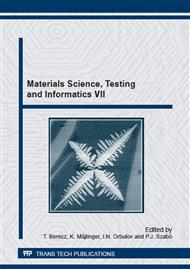p.119
p.125
p.131
p.137
p.143
p.149
p.155
p.161
p.167
Influence of Sintering Time on Properties of Alumina-Based Ceramic Composite
Abstract:
The authors have investigated the influence of sintering time at 1600 °C on microstructure, shrinkage, density, surface hardness and bending strength of Al2O3 based ceramic composites. From the ceramic powder mixes, the specimens were compacted by uniaxial pressing and during sintering the heating gradient was 100 °C/h. The experiments have shown that at 1600°C of sintering temperature, the specimen densifications have almost finished within 5 hours, meanwhile the crystal grows processes were continued for up to 9 hours of sintering. The authors have found that the maximum values of hardness and mechanical bending strength of specimens were obtained at 5 hours of sintering and these values have slowly decreased with increasing the sintering times.
Info:
Periodical:
Pages:
143-147
Citation:
Online since:
February 2015
Authors:
Keywords:
Price:
Сopyright:
© 2015 Trans Tech Publications Ltd. All Rights Reserved
Share:
Citation:


